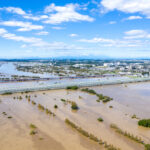On October 9, 2019, Prime Minister Abe hosted the Green Innovation Summit, bringing together representatives of a series of international conferences to exchange views on measures for accelerating disruptive innovations to realize a decarbonized society. Mizuno Tetsu reports.
Meteorological disasters, such as huge typhoons, hurricanes, floods, sea level rises and forest fires, have increased in recent years. In addition, extreme phenomena related to the sea surface temperature, such as El Niño and La Niña, have had a larger impact.
Japan is no exception. Localized sudden torrential downpours called “guerrilla thunderstorms” occurred, which the country had never experienced before, and tornadoes caused damage that the country had never seen. The damage spread to both urban and local areas without warning.
Japan was struck by unprecedented natural disasters in October 2019, and the damage reached a large number of areas. Fourteen typhoons approached the country from July to October, and five made landfall. These numbers are not particularly outstanding compared with those in previous years. Typhoon No.19 (Hagibis), however, which made landfall in Japan on October 12, brought heavy rains to the Kanto, Koshin and Tohoku regions. The typhoon triggered the bursting of many riverbanks and caused serious flood damage to 391 cities, towns and villages in fourteen prefectures. The electricity and water supplies were cut off in many areas. Many train services were temporarily suspended. The typhoon destroyed 4,044 houses completely or partially and left 100 people dead or missing.
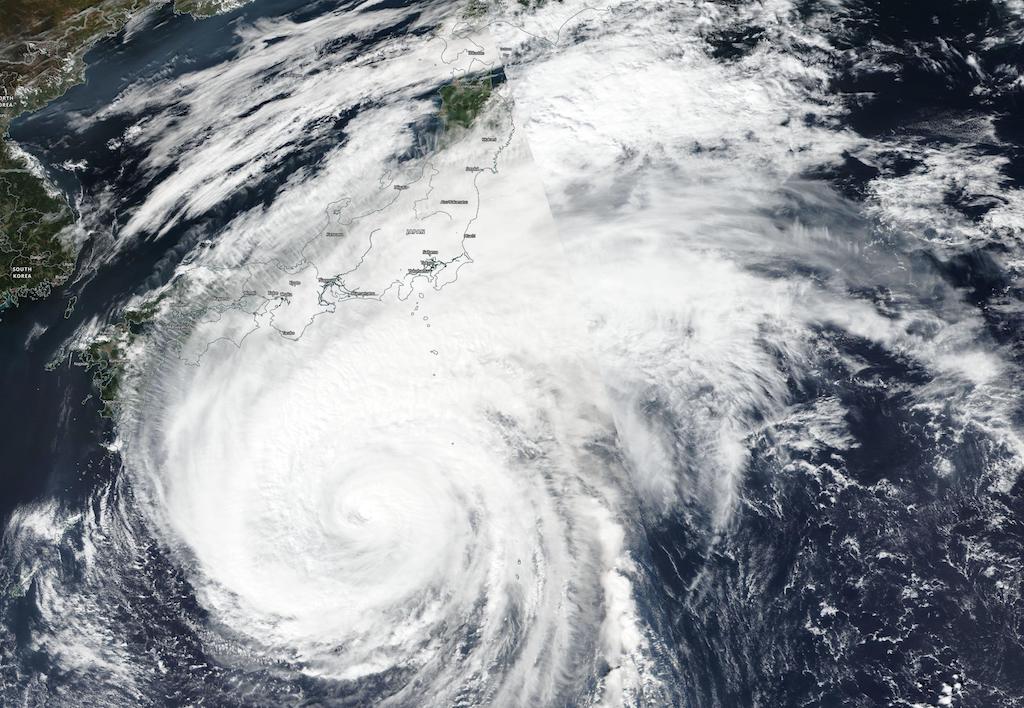
NASA-NOAA’s Suomi NPP satellite passed over Typhoon Hagibis and revealed that the eye had become cloud-filled as the storm weakened from a super typhoon to a typhoon. The eye was surrounded by powerful thunderstorms and a large tail of clouds that covered most of Japan. Credit: NASA Worldview, Earth Observing System Data and Information System (EOSDIS)
https://blogs.nasa.gov/hurricanes/tag/hagibis-2019/
At the time, the Rugby World Cup, which was being held in Japan, was also affected, and three of the seven matches scheduled for October 12 to 13 were cancelled. There was a lot of talk about Japan’s regret at the cancellation of the matches as the host country. The Canadian team, which had been scheduled to compete in a match in Kamaishi City, Iwate Prefecture, helped the local people remove the earth and sand that flowed into the city without showing their disappointment. Perhaps this could be said to be the most symbolic scene of the Rugby World Cup in Japan, as well as the great matches.
National Resilience
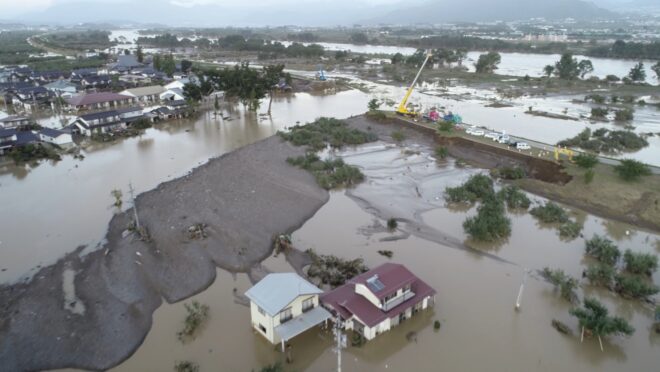
An affected area in the vicinity of Oaza-hoyasu, Nagano City, Nagano Prefecture. The farming acreage in Nagano City, which was massively damaged, is about 8,000 ha. They cultivate mainly apples and rice, which were severely damaged. Source: TJJ created this image based on a video shot by the Geospatial Information Authority of Japan on October 13, 2019. https://www.gsi.go.jp/common/000219418.mp4https://blogs.nasa.gov/hurricanes/tag/hagibis-2019/
The confirmed amount of damage to agriculture, forestry and fisheries caused by Hagibis totaled 126.88 billion yen as of October 29. The affected areas have a large amount of disaster waste, and this waste is projected to take more than two years to dispose of. The government sent its investigation team to the affected areas. The Self-Defense Forces, firefighters in each local government and people involved in disaster damage control coped with the situation in their own ways. For an appropriate, rapid recovery and reconstruction from the serious damage caused by Typhoon No.19, the government designated the typhoon as a “disaster of extreme severity” to strengthen the financial support for the affected local governments and as an “extraordinary disaster” to act for part of the recovery projects based on the Act on Reconstruction from Large-scale Disasters at a Cabinet meeting on October 29.
It is necessary to proceed steadily with disaster damage control and mitigation measures, such as flood control and early warning systems, as well as national resilience plans, which the government has implemented to date. Disaster damage control and mitigation measures for natural disasters, such as the Great Hanshin-Awaji Earthquake of 1995, the Great East Japan Earthquake of 2011 and the 2016 Kumamoto Earthquake, spread throughout local governments nationwide, and an approach toward and actions for preparing for disasters prevailed as nationwide unified efforts. Nationwide, elementary school students act to improve local disaster damage control capabilities by getting adults involved, and disaster damage control is becoming a quiet national movement. Nevertheless, Hagibis was a huge new disaster that made people strongly aware of the importance of making even greater efforts. It was unexpected and extremely shocking that infrastructure that had been improved in pursuit of safety and convenience was unable to withstand Hagibis. However, it is necessary to examine infrastructures that have already begun to be retired or infrastructures that are not based on hypothetical large-scale disasters as soon as possible and to strengthen disaster measures from the perspectives of both software and hardware.
In the short term, Japan will work on national resilience according to the Basic Act for National Resilience Contributing to Preventing and Mitigating Disasters for Developing Resilience in the Lives of the Citizenry, which came into effect in 2013, and the Action Plan based on this Basic Act in efforts to protect the lives of the people and control economic losses, and it will strengthen global warming measures in the long and medium term.
Global warming measures carried out within an international framework take a long time to achieve results. Japan needs to fulfill its contribution as an advanced disaster measure country as well as expand the global warming measures and techniques that it has worked on to date and provide them to the world.
On October 13, the UN Secretary-General António Guterres extended his deep condolences to the families of the victims, the Government and people of Japan. In his message, he said, “Today, on the International Day for Disaster Risk Reduction, the Secretary-General highlights the importance of investing in climate resilience, pointing out the important leadership role Japan has played in this area, as evidenced in its extensive and efficient preparation for this latest extreme weather event.”
The Secretary-General went on, “The United Nations stands in solidarity with the Government and people of Japan.”
Regardless of whether it is good or bad, Japan has unintentionally experienced many large-scale natural disasters and also prepares for expected future natural disasters. That is why Japan has a significant role to play.
Rising Global Temperatures
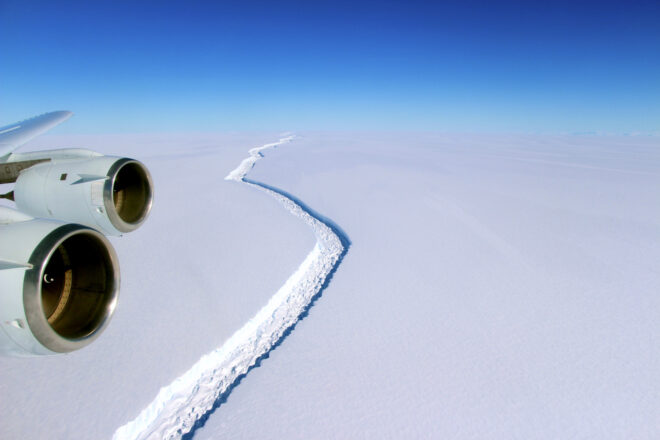
In January 2017, scientists warned that the Larsen C Ice shelf in Antarctica was close to breaking point.
Photo: NASA PHOTOGRAPH BY JOHN SONNTAG
On October 12, when Hagibis made landfall on the Izu Peninsula, Shizuoka Prefecture, a sea temperature of 27˚C, one degree higher than in an average year, was recorded on the southern side of the Japanese Archipelago. As a typhoon approaches the Japanese Archipelago, it tends to weaken as the sea temperature declines. It is thinkable, however, that Hagibis made landfall in Japan by maintaining its huge momentum due to the sea temperature of 27˚C, one degree higher than in an average year.
It is clear from data released by the National Aeronautics and Space Administration (NASA) that global temperatures, including sea temperatures, are continuing to rise. The temperature rises since the 2000s are frightening. Disappointingly, we cannot afford to see meteorological observation data in idleness.
On January 5, 2017, the Project MIDAS, a UK-based Antarctic research project, reported that the Larsen C ice shelf in Antarctica is primed to shed an area of more than 5,000 square km following further substantial rift growth and a half year later, early July 2017, an iceberg named A-68, weighing more than one trillion tones, calved from the Larsen C ice shelf.
On September 26, 2019, another larger iceberg separated from the Amery ice shelf in Antarctica, and it was named D-28. It measures 1,636 square km and weighs about 315 billion tons.
On October 27, the Governor of California declared a statewide emergency due to the effects of unprecedented high-wind events that resulted in the Kincade fires in Sonoma County and evacuations across the state. Around the same time, a forest fire burned through more than 2,000 ha of land, including areas inhabited by koalas, in New South Wales, southeastern Australia. And in Brazil, the Amazon rainforest is still burning.
Scientists agree that large-scale natural disasters are increasing due to the effects of climate change caused by diverse factors. If the ice shelves on the Antarctic sink further into the sea, it may lead to a rise in the sea level. If the Amazon rainforest, which absorbs carbon dioxide and produces about 20% of the oxygen on Earth, burns down, it will lead to an irreparable situation for the planet.
The Paris Agreement and Japan
The Paris Agreement, which was reached at COP21 in November 2015 and came into effect on November 4, 2016, is an epoch-making framework for humankind in deciding to address this huge issue that has been evolving since the industrial revolution, the reduction of greenhouse gas (GHG) emissions, by using the know-how and technologies that it has acquired over a long period of time through international cooperation. Within the framework participated in by most countries around the world, including major emitters, signatories agreed on holding the increase in the average global temperature to well below 2˚C above pre-industrial levels and pursuing efforts to limit the temperature increase to 1.5˚C as long-term goals. They also aimed to achieve an equal balance between GHG emissions by human beings and the amount of their absorption in the latter half of the twenty-first century and agreed that the overall progress for the achievement of these long-term goals would be evaluated at five-year intervals starting in 2023.
The Paris Agreement was finally reached following Earth Summit 1992 that was held in Rio de Janeiro, which made the world strongly aware of and discuss the issue of global warming, and the Kyoto Protocol of 1997. The Paris Agreement, which was reached amid unresolved conflicts among developed economies and between developed and developing economies, is of great significance. With the serious situation mentioned at the beginning looming, it goes without saying that humankind needs to rack its brains under the Agreement.
In response to the Paris Agreement, the Japanese government approved a “Plan for Global Warming Countermeasures” aimed at significantly reducing GHG emissions at a Cabinet meeting in May 2016. Yamaji Kenji, Senior Vice President/Director-General of the Research Institute of Innovative Technology for the Earth, who was involved in this plan, says, “I rate highly the fact that the Paris Agreement includes both each country’s voluntary targets for the reduction and control of GHG emissions and the long-term goal to be achieved by the whole world.”
It is in the energy-saving area that Japan plays a large role for global warming measures under the Paris Agreement. Following two oil crises in the 1970s, the industrial community made extensive efforts to save energy, which subsequently took root as a national movement. Coupled with the traditional Japanese “mottainai” spirit, energy-saving efforts spread from the industrial community to ordinary homes, transportation and buildings. In addition, the Great East Japan Earthquake of 2011 resulted in a major shift in the energy mix policy, including the nuclear power generation that Japan had aimed for. It is becoming extremely important to promote renewable energy and improve the efficiency of coal-fired thermal power generation, as well as to restart safe nuclear power stations. This is a pressing issue, and the development of this technology and further technological solutions will also lead to Japan’s international contribution.
In April 2016, the government formulated the National Energy and Environment Strategy for Technological Innovation towards 2050 (NESTI 2050). This strategy showed energy system integration technologies intended to maximize energy consumption efficiency by utilizing artificial intelligence (AI) and big data throughout the entire society as key technological areas that the country should develop. Specific examples of these technologies include ultra-light heat-resistant materials that improve energy efficiency, next-generation batteries that go beyond the limits of lithium ion cells, next-generation solar power generation with new materials and structures, and technologies to effectively utilize carbon dioxide separated and captured from exhaust gases. In addition, biofuel made from euglena, the fuel used for the bus that traveled to the location of the G20 Ministerial Meeting on Energy Transitions and Global Environment for Sustainable Growth, is also worth notable attention.
Japan’s efforts to overcome the pollution problem and the two oil crises in the 1970s resulted in its active engagement in the global warming issue. Those efforts led to the production of the CVCC engine of Honda Motor Co., a blue light-emitting diode that was considered to be unlikely to be manufactured in the twentieth century, as well as hybrid vehicles of Toyota Motor Corporation, carbon fiber that prompted a material revolution, high-performance industrial furnaces and high-performance boilers. These experiences resulted in international contributions while helping strengthen competitiveness in the global market.
These experiences showed that efforts to tackle the environmental problem and the global warming issue were not costs, but a chance to acquire technologies and markets, and that they could be balanced with the economy.
Green Innovation, Japan’s International Contribution
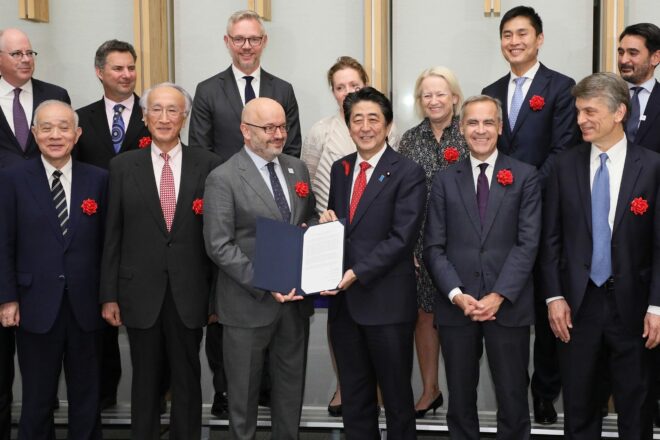
Prime Minister of Japan Abe Shinzo receives a proposal from representatives of a series of international conferences at the Green Innovation Summit in Tokyo, October 9, 2019.
Japan’s GHG emissions account for around 2.8% of the overall global emissions. Japan has implemented the Joint Crediting Mechanism (JCM) with developing countries and has also held the Innovation for Cool Earth Forum (ICEF) annually since 2014. The aim of ICEF is for global leaders to get together, discuss climate change measures through technological innovations and send out information on innovations in energy and environmental technologies.
The Global Warming Prevention Headquarters held on June 11, 2019 compiled the Long-Term Strategy under the Paris Agreement as A Growth Strategy.
At this meeting, Prime Minister Abe said, “Responding to climate change is no longer a cost for the economy, but a growth strategy for the future. By firmly creating a virtuous cycle between the environment and growth, Japan will take the lead in making a paradigm shift in global environmental policy.” He also said, “We will hold a Green Innovation Summit in Japan this autumn, which will bring together top-tier researchers from around the world as well as representatives from the industrial and financial communities, and take the lead in driving global initiatives.”
The Green Innovation Summit was held in Tokyo on October 8–11. The abovementioned ICEF, the Research and Development 20 for Clean Energy Technologies (RD20) where top global researchers get together and the TCFD (Task Force on Climate-related Financial Disclosures) Summit were held simultaneously. The participants exchanged opinions about measures for accelerating discontinuous innovations to achieve a decarbonized society, and the commitments of the people involved were confirmed. This was just before Hagibis hit Japan.
Prime Minister Abe stated that Japan [i] will inaugurate an international joint research base for zero emission technologies, as a hub of aggregated knowledge from all over the world, [ii] will formulate a Zero Emission Innovation Strategy by the end of 2019 and aim to encourage the public and private sectors to invest in research and development in the area of energy and environment at a level of 30 trillion yen for a decade, and [iii] has just formulated a Green Investment Guidance, guidelines of which financial institutes and other organizations make use in assessing environmental investment.
Representatives of a series of international conferences handed Prime Minister Abe a message for the future enhancement of specific efforts by industrial players, financial industries and researchers toward the achievement of a virtuous cycle of environmental friendliness and economic growth, a goal on which the G20 leaders agreed.
On October 16, 2019, regarding these large-scale meteorological disasters that are considered to be caused by the global warming issue, Prime Minister Abe said at an extraordinary session of the Diet, “Instead of taking measures as an extension of the ones we have carried out to date, Japan will create discontinuous innovations and take the lead in global measures for realizing the ultimate decarbonized society.”
Now the spirit of “One for all, All for one” is required under the Paris Agreement.
MIZUNO Tetsu is a freelance writer.
[This article first appeared in the November/December 2019 issue of the Japan Journal.]


